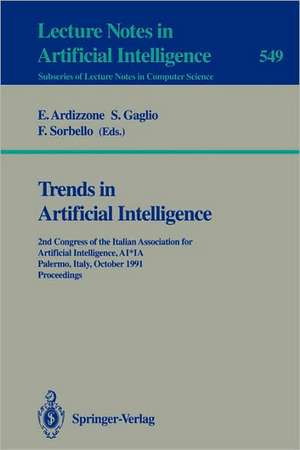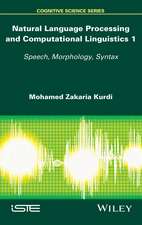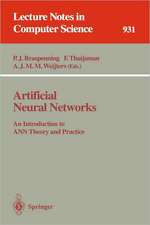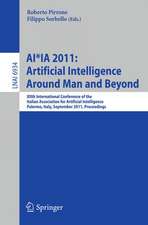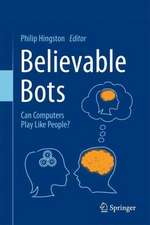Trends in Artificial Intelligence: 2nd Congress of the Italian Association for Artificial Intelligence, AI*IA, Palermo, Italy, October, 29-31, 1991. Proceedings: Lecture Notes in Computer Science, cartea 549
Editat de Edoardo Ardizzone, Salvatore Gaglio, Filippo Sorbelloen Limba Engleză Paperback – 9 oct 1991
Din seria Lecture Notes in Computer Science
- 20%
 Preț: 1061.55 lei
Preț: 1061.55 lei - 20%
 Preț: 340.32 lei
Preț: 340.32 lei - 20%
 Preț: 341.95 lei
Preț: 341.95 lei - 20%
 Preț: 453.32 lei
Preț: 453.32 lei - 20%
 Preț: 238.01 lei
Preț: 238.01 lei - 20%
 Preț: 340.32 lei
Preț: 340.32 lei - 20%
 Preț: 438.69 lei
Preț: 438.69 lei -
 Preț: 449.57 lei
Preț: 449.57 lei - 20%
 Preț: 343.62 lei
Preț: 343.62 lei - 20%
 Preț: 148.66 lei
Preț: 148.66 lei - 20%
 Preț: 310.26 lei
Preț: 310.26 lei - 20%
 Preț: 256.27 lei
Preț: 256.27 lei - 20%
 Preț: 645.28 lei
Preț: 645.28 lei - 17%
 Preț: 427.22 lei
Preț: 427.22 lei - 20%
 Preț: 655.02 lei
Preț: 655.02 lei - 20%
 Preț: 307.71 lei
Preț: 307.71 lei - 20%
 Preț: 1075.26 lei
Preț: 1075.26 lei - 20%
 Preț: 591.51 lei
Preț: 591.51 lei -
 Preț: 381.21 lei
Preț: 381.21 lei - 20%
 Preț: 337.00 lei
Preț: 337.00 lei - 15%
 Preț: 438.59 lei
Preț: 438.59 lei - 20%
 Preț: 607.39 lei
Preț: 607.39 lei - 20%
 Preț: 538.29 lei
Preț: 538.29 lei -
 Preț: 389.48 lei
Preț: 389.48 lei - 20%
 Preț: 326.98 lei
Preț: 326.98 lei - 20%
 Preț: 1414.79 lei
Preț: 1414.79 lei - 20%
 Preț: 1024.44 lei
Preț: 1024.44 lei - 20%
 Preț: 579.30 lei
Preț: 579.30 lei - 20%
 Preț: 575.48 lei
Preț: 575.48 lei - 20%
 Preț: 583.40 lei
Preț: 583.40 lei - 20%
 Preț: 763.23 lei
Preț: 763.23 lei - 15%
 Preț: 580.46 lei
Preț: 580.46 lei - 17%
 Preț: 360.19 lei
Preț: 360.19 lei - 20%
 Preț: 504.57 lei
Preț: 504.57 lei - 20%
 Preț: 172.69 lei
Preț: 172.69 lei - 20%
 Preț: 369.12 lei
Preț: 369.12 lei - 20%
 Preț: 353.50 lei
Preț: 353.50 lei - 20%
 Preț: 585.88 lei
Preț: 585.88 lei -
 Preț: 410.88 lei
Preț: 410.88 lei - 20%
 Preț: 596.46 lei
Preț: 596.46 lei - 20%
 Preț: 763.23 lei
Preț: 763.23 lei - 20%
 Preț: 825.93 lei
Preț: 825.93 lei - 20%
 Preț: 649.49 lei
Preț: 649.49 lei - 20%
 Preț: 350.21 lei
Preț: 350.21 lei - 20%
 Preț: 309.90 lei
Preț: 309.90 lei - 20%
 Preț: 122.89 lei
Preț: 122.89 lei
Preț: 342.46 lei
Preț vechi: 428.07 lei
-20% Nou
Puncte Express: 514
Preț estimativ în valută:
65.55€ • 67.55$ • 55.34£
65.55€ • 67.55$ • 55.34£
Carte tipărită la comandă
Livrare economică 04-18 martie
Preluare comenzi: 021 569.72.76
Specificații
ISBN-13: 9783540547129
ISBN-10: 3540547126
Pagini: 500
Ilustrații: XIV, 486 p.
Dimensiuni: 155 x 235 x 26 mm
Greutate: 0.69 kg
Ediția:1991
Editura: Springer Berlin, Heidelberg
Colecția Springer
Seriile Lecture Notes in Computer Science, Lecture Notes in Artificial Intelligence
Locul publicării:Berlin, Heidelberg, Germany
ISBN-10: 3540547126
Pagini: 500
Ilustrații: XIV, 486 p.
Dimensiuni: 155 x 235 x 26 mm
Greutate: 0.69 kg
Ediția:1991
Editura: Springer Berlin, Heidelberg
Colecția Springer
Seriile Lecture Notes in Computer Science, Lecture Notes in Artificial Intelligence
Locul publicării:Berlin, Heidelberg, Germany
Public țintă
ResearchCuprins
Knowledge-based media coordination in intelligent user interfaces.- Some notes on cumulative reasoning.- A family of three-valued autoepistemic logics.- Viewpoints subsume beliefs, truth and situations.- Automating meta-theory creation and system extension.- Implementing exceptions in inheritance by concept transforming actions.- Approximate entailment.- Negation as failure and constraints through abduction and defaults.- A hybrid system with datalog and concept languages.- Optimal search for conjunctive goals using constraints.- FSS-WASTL interactive knowledge acquisition for a semantic lexicon.- Hybrid encoding: Constraints on addressing structure.- Uncertainty and cyclic dependencies a proposal and a network implementation.- Abductive reasoning in a multi-theory framework.- The abstract interpretation of hybrid rule/frame-based systems.- Taxonomic reasoning in configuration tasks.- Representation and use of teleological knowledge in the multi-modeling approach.- Towards the integration of different knowledge sources in model-based diagnosis.- Integrating statistics, numerical analysis and dependency-recording in model-based diagnosis.- Version-space induction with multiple concept languages.- Knowledge compilation to speed up numerical optimization.- New perspectives about default hierarchies formation in learning classifier systems.- Use of a causal model to learn diagnostic knowledge in a real domain.- Extending inverse resolution to build up abstractions.- Using word association for syntactic disambiguation.- A computational model of tense selection and its experimentation within an intelligent tutor.- An efficient context-free parsing algorithm with semantic actions.- From scopings to interpretation: The semantic interpretation within the AlFresco system.- Parsing dependency grammars.- A system based on neural architectures for the reconstruction of 3-D shapes from images.- Retrieval of high-level data structures from stereo vision data.- High-level and low-level computer Vision: Towards an integrated approach.- An associative link from geometric to symbolic representations in artificial vision.- A theory of sensor-based robot navigation using local information.- Insights into cooperative group design: Experience with the LAN designer system.- Direct interaction among active data structures: A tool for building AI systems.- Introducing knowledge representation techniques in database models.- Self-organizing maps: A new digital architecture.- Electrical equipment maintenance training: An its application in industrial environment.- Temporal and spatial data and default assumptions in DIPSY-E system.- Visual indexing with an attentive system.- On neural network programming.- A logic for the representation of spatial knowledge.- Truth maintenance in approximate reasoning.- A strategy for design and development of complex knowledge-systems.- Efficient compilation of first order predicates.- A flexible tool for assumption-based user modeling.- KL: A neural model for capturing structure in speech.- Lexical discrimination within a multilevel semantics approach.- Metalevel representation of analogical inference.- Semantic interpretation of copulative sentences.- Typicality for plausible reasoning.- A distributed image-understanding system.
